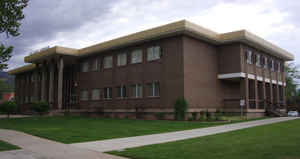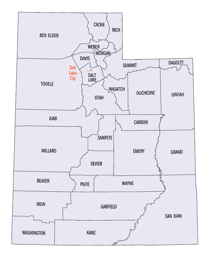Utah Counties
There are twenty-nine counties in the State of Utah. There were originally seven counties established under the provisional State of Deseret in 1849: Davis, Iron, Sanpete, Salt Lake, Tooele, Utah, and Weber. The Territory of Utah was created in 1851 with the first territorial legislature meeting from 1851-1852. The first legislature re-created the original counties from the State of Deseret under territorial law as well as establishing three additional counties: Juab, Millard, and Washington. All other counties were established between 1854 and 1894 by the Utah Territorial Legislature under territorial law except for the last two counties formed, Daggett and Duchesne.Iron County, Utah
Iron County Education, Geography, and History

Iron County is a county located in the state of Utah. Based on the 2010 census, the population was 46,163. Its county seat is Parowan, and
the largest city is Cedar City. The county was created in 1850 and organized the following year. It was originally named Little Salt Lake
Valley, and renamed for the iron mines west of Cedar City.
The Cedar City, UT Micropolitan Statistical Area includes all of Iron County.
Etymology - Origin of Iron County Name
The county was originally named Little Salt Lake Valley, and renamed for the iron mines west of Cedar City.
Demographics:
County QuickFacts: CensusBureau Quick Facts
Iron County History
Iron County is a study in contrast from its arid western reaches of Escalante Desert and Great Basin ranges to the meadows and forests of the High Plateau on the east. The Markagunt Plateau is creased by the colorful formations of Cedar Breaks National Monument, a kind of miniature Bryce Canyon. Brian Head (11,307 feet), named for a profile resembling William Jennings Bryan, rises abruptly behind Iron County's major string of settlements and extracts a toll of precipitation from passing westerlies to feed the headwaters of the Sevier River.Parowan Valley was home to the Fremont people who constructed granaries and pit houses dating from about A.D. 750 to 1250. An unusual variety of petroglyphs of different periods were pecked into the stone of Parowan Gap about 12 miles northwest of Parowan. Cedar City is the tribal headquarters of the modern Southern Paiute Indian Reservation. Their ancestors used the plants and animals of the basin/plateau environment in a complex seasonal pattern. The Dominguez-Escalante expedition traveled through the area on October 12, 1776, on its unsuccessful search for a route to central California. Fur trapper Jedediah S. Smith was the first Anglo-American to visit present Iron County during his amazing journey of 1826. Mormon settlers dispatched by Brigham Young established Parowan in January 1851 as the mother colony of the southern frontier. Cedar City (originally Coal Creek) was founded the same year. Several pioneer log homes remain in the county as well as some English two-bay log barns now very rare in the state.
Coal in the canyons east of Cedar City and iron ore in the mountains west inspired the early Iron Mission that proved marginally successful as a pioneer attempt at self-sufficiency. Modern mining and transportation turned Iron toward a new era befitting the county name. Old Iron Town still has a fine beehive coking oven among its ruins. The west end of the county also has some historic and current precious metal mining. The Escalante Desert has changed its name to Escalante Valley, reflecting the rich irrigation agriculture of hay, small grains, and potatoes.
Iron County has a more balanced and broadly based economy than most of rural Utah. Located on Interstate 15, Cedar City is 500 miles from Los Angeles, 180 miles from Las Vegas, and 260 miles from Salt lake, and about midway between L.A. and Denver via I-70. Its location and size have made it a regional trade center and supplier of services. The concessionaire for nearby national parks (an edge of Zion is in the county) has offices here, as do regional offices of the Bureau of Land Management, Dixie National Forest, and Utah Wildlife Resources. A railroad spur and regional airline still serve the city. A rocket motor fuel plant is under construction. A very good four-year liberal arts college, Southern Utah State, combined with a peerless Shakespearean Festival in the summer make Cedar City an attractive stop for some of the more than one million people who annually pass through.
*Sources: Beehive History 14: Utah Counties. 1988. Utah State Historical Society, 300 Rio Grande, Salt Lake City, UT 84101-1182.
Geography: Land and Water
As reported by the Census Bureau, the county has a total area of 3,302 square miles (8,552 km2), of which,
3,298 square miles (8,542 km2) of it is land and 4 square miles (10 km2) of it (0.12%) is water. A small part of
Zion National Park extends northward into the county, near Kanarraville. Cedar Breaks National Monument is
located entirely within the county, near its southeastern corner.
Neighboring Counties
Bordering counties are as follows:
- Washington County, Utah: (south)
- Kane County, Utah: (southeast)
- Garfield County, Utah: (east)
- Beaver County, Utah: (north)
- Lincoln County, Nevada: (west)
Education







